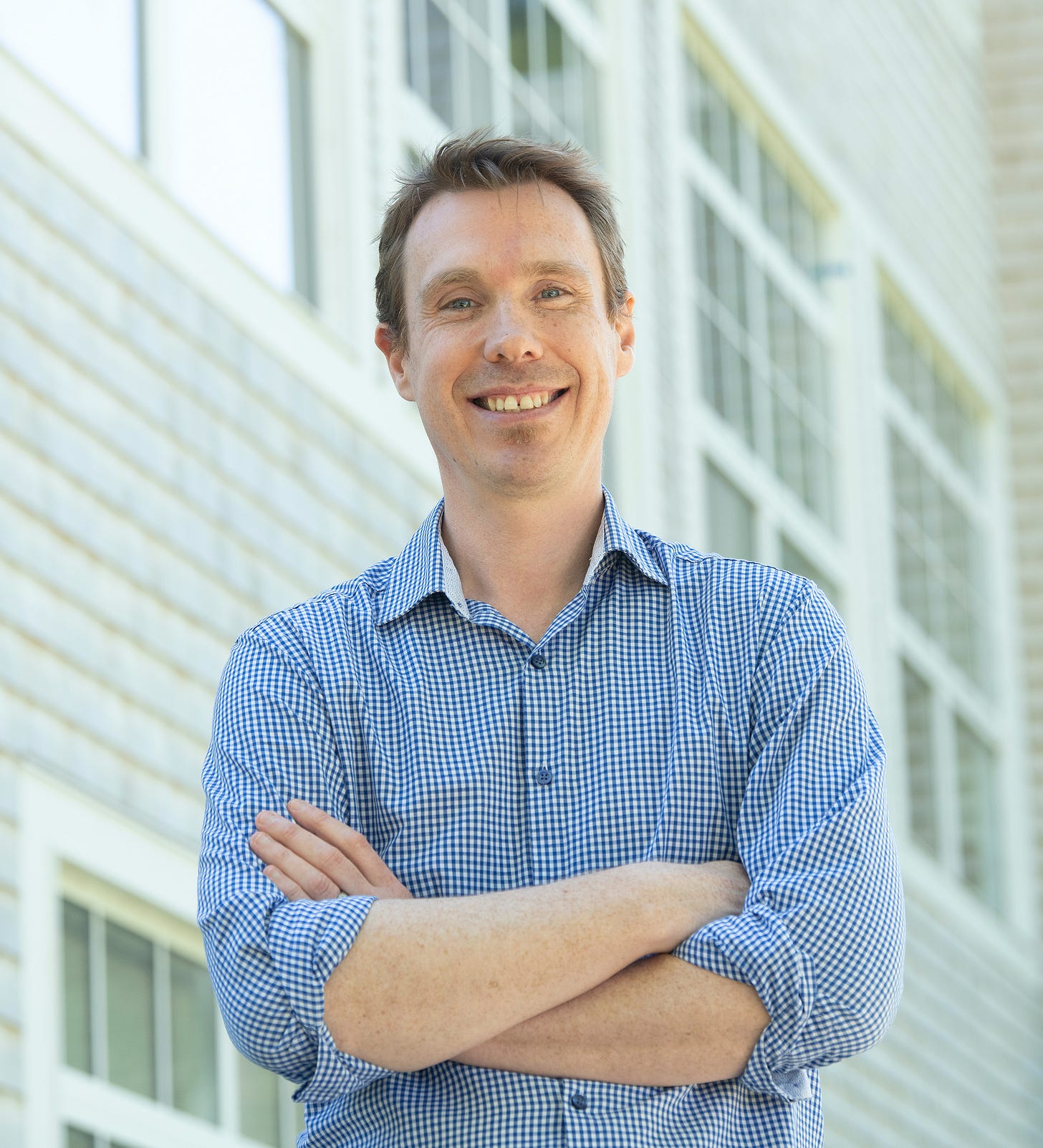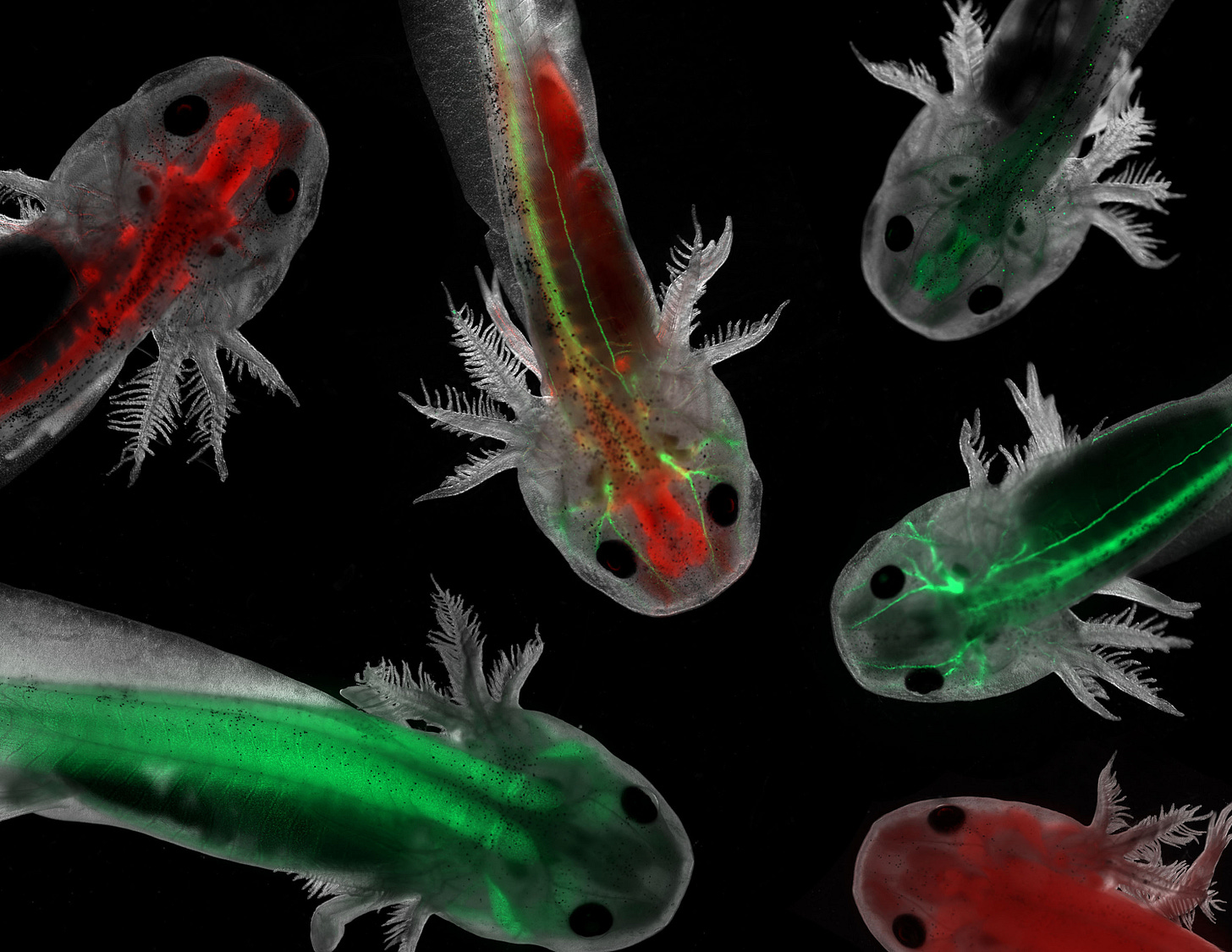These strange animals may help unlock revolutionary new science. There are thousands of them in Bar Harbor.
MDI Biological Laboratory scientists love their 'crazy critters'
At a few days old, an axolotl is hardly bigger than a grain of rice, newly hatched out of its gelatinous egg and wriggling alongside its hundreds of brothers and sisters. Despite its size, you can make out the physical characteristics that have made it so captivating to both ancient and modern people: its pink, frilly external gills, its tiny black eyes that look like they were drawn with a Sharpie, and its wide, faintly upturned mouth, a bit like a pit bull puppy with its toothy perma-smile. Even at fingernail size, they’re awfully cute.
There are thousands of them at the Mount Desert Island Biological Laboratory in Bar Harbor, housed in temperature controlled rooms packed with little aquariums; the rooms smell earthy and organic, like a boggy forest after a spring rain. At first, the axolotls paddle around in group enclosures filled with water that is tightly monitored for its quality. Once they reach a certain age, however, they turn cannibalistic, and have to be separated into individual tanks.
“After about a month, they start to look at each other and think, ‘Hmm, you look tasty,’” said James Godwin, a leading scientist at the lab that studies these peculiar creatures. “There can be six in a tank, and you’ll leave for the weekend and come back on Monday, and there will be one left, chomping on the last of its siblings. It makes sense why evolution has given them the ability to grow their arms back, with that kind of behavior.”
It’s that ability - salamanders in general can regenerate their limbs and other body parts - that have made them the subject of decades of research at MDI Bio Lab and other research institutions around the world. Axolotls in particular go one step further with their regenerative abilities than other salamander species - they can grow back not only limbs, but also heart and kidney tissue, and even parts of their brains or spinal cords. They’re also easy to study, with the translucent tissue of captive-bred strains, and their relative hardiness in captivity. In other words: they’re a research scientist’s dream.
Axolotls are endemic to a specific series of interconnected wetlands near Mexico City, which were drained by Spanish colonizers and which pushed them to the brink of extinction, though modern populations are slowly recovering. The Aztec identified the axolotl with the god Xolotl, the twin brother of Quetzelcoatl and ruler of, among other things, monsters, deformities and death, helping guide the recently deceased to the underworld.
Transformation - mythical, physical and scientific - is central to the story of the axolotl, and to salamanders in general. The salamanders you find across New England - the ones that migrate en masse in early spring, on rainy nights colloquially called the ‘Big Night’ - are among the most closely related to the Mexican axolotl.
“The ones in Mexico and the ones in North America, that are quite common here in Maine, in fact, are very, very similar,” Godwin said. “The ones that evolved in Mexico, however, had this special quality where they are neotenic, meaning they don’t go through metamorphosis. They’re forever teenagers. Out of all 700-ish species of salamanders in the world, they’re the only ones that do that. They’re the freaks of the salamander world. That’s why they are so special.”
Godwin - an affable, enthusiastic Australian - is an immunologist, first drawn to his particular field of study by fundamental questions about why humans and most other mammals have such limited regenerative abilities, while amphibians like the axolotl have such robust capabilities. His belief - now confirmed by years of scientific study - is that the axolotl’s regenerative abilities are, essentially, an immune response.

“The immune system controls everything, in a way,” Godwin said. “Disease, especially age-related disease. If you’re injured, it is the immune system responding. Understanding the immune system is central for keeping humans healthy. And most people are terrified by immunology, but I love it. I think it’s amazing.”
Think of it this way: if you have a heart attack, your heart is damaged. Microphages, a type of white blood cell, rush in and start growing tissue where the damage has occurred, but it isn’t a perfect replica of healthy heart tissue; it’s scar tissue. As you might surmise, scar tissue isn’t good. It’s weaker, it’s less flexible, and it can cause lots of complications. The larger amount of it there is, the worse outcomes for the person there can be.
If the same thing were to happen to an axolotl, however, the tissue its macrophages would grow would be the real deal; heart muscle tissue, not scar tissue. Same with limbs, eyes, kidneys, other organs. You can see why this extraordinary ability from this odd little amphibian makes scientists like Godwin start vibrating with excitement.
It is not out of the realm of possibility, Godwin believes, that within the next few decades - or possibly even sooner - we could see treatments derived from axolotl research that would allow, say, kidney tissue to be regrown, damaged heart tissue to be repaired, severed spinal cords to be reconnected or new organs to be grown that would be specific for the individual human, meaning the body would be far less likely to reject it than today’s transplants.
“With modern-day cell therapies and immunotherapies, I think the timeline is relatively short,” he said. “If we can find the right insights into why salamanders don’t scar, and we can transfer those into human cellular therapy, I think we’re not looking at 25 years. We’re looking at half that. I feel confident we will see this in our lifetimes.”
Godwin is one of many scientists at MDI Bio Lab that are part of a long legacy of research into regeneration. In the axolotl lab currently, he and his colleagues Prayag Murawala, a molecular biologist, and Joel Graber, a data scientist, use their different scientific backgrounds to power and deepen their research. Other scientists study the zebrafish, and nematode worms; all are working toward the same goal of unlocking the potential found in the genes of other animals.

Founded initially by Tufts University in 1898 in the Midcoast town of Harpswell, MDI Bio Lab moved to its permanent home on Salisbury Cove on Mount Desert Island in 1921, attracted there by land purchased for them by John D. Rockefeller, Acadia National Park co-founder George B. Dorr and other island philanthropists.
The institute sits on a quiet spot of land jutting out into Frenchman Bay, with New England-style cottages and laboratory buildings spread out among its picturesque 100 acres. From its founding, its scientists have sought to understand certain basic biological functions and, from there, develop novel medical treatments - initially, using the cold water sea creatures plucked in great abundance from the bay. The lab’s research on spiny dogfish - small sharks that are common in the Gulf of Maine - led to breakthroughs in treating liver and kidney disease.
In the 1990s, the study of regeneration came to the forefront at MDI Bio Lab, and in 2012, the Kathryn W. Davis Center for Regenerative Biology and Aging opened on its campus, where the axolotls are held, as well as the zebrafish and nematodes that are also crucial to the study at the lab.
“So much of our work is saying, ‘OK, the instructions for how to turn these genes on or off, or to tell a cell to do one thing or another - these are all right there,’” said Jeri Bowers, chief of staff at MDI Bio Lab. “It then becomes a question of, can we access them? Can we do it in a way that is predictable and safe? That sounds relatively simple, but of course, it certainly is not.”
MDI Bio Lab is just a few miles north of Jackson Laboratory, its more famous cousin, with its amazingly engineered mice that have contributed to countless scientific breakthroughs all over the world. Godwin has a dual appointment at both facilities; he takes his cell research from the MDI Bio Lab axolotls, and puts it into the Jackson Lab mice, which are a much better model for eventual applications in humans.
“I can do things here that I simply could not do anywhere else in the world,” Godwin said. “Maine seemed incredibly remote to me, as an Australian. But it is incredibly special.”
For now, Godwin and the other scientists in Bar Harbor are busily plugging away at their research, searching for the keys that will unlock further advancements in regenerative medicine. Godwin will soon publish a paper that shows their success with mice with axolotl DNA regrowing severed digits.
Digits are only the beginning, however, of breakthroughs that Godwin and his colleagues believe will have far-reaching potential for the treatment of a variety of conditions.
“We have a lot to learn from these crazy critters,” Godwin said. “I feel incredibly privileged to be able to pursue this research, and with such a fascinating animal. It never gets old.”





I am now armed with very cool axolotyl knowledge. Thank you!